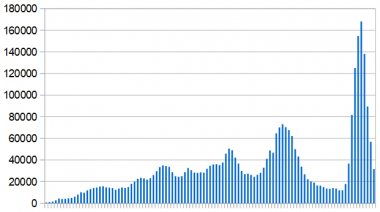
The Moroccan interior ministry has swung into action over a cartoon (above) published in the daily newspaper, Akhbar al-Youm, last weekend.
Police detained and interrogated editor/publisher Taoufik Bouachrine and cartoonist Khaled Kadar for more than 24 hours. They also sealed off the paper's offices, denying access to dozens of staff.
The cartoon refers to Prince Moulay Ismail, a cousin of the king, who was recently married. It shows him sitting on an amariya (a chair used for wedding ceremonies) with what appears to be a Moroccan flag in the background.
A statement from the interior ministry described the cartoon as showing "blatant disrespect to a member of the royal family". It continued:
In addition to tendentiously using the national flag, the cartoon undermines a symbol of the nation by insulting the emblem of the kingdom ... The use of the Star of David in the cartoon raises many questions on the insinuations of the people behind it and suggests flagrant anti-semitic penchants.
In light of the elements at hand, the interior minister has decided, in accordance with the laws in force, to sue and seize the daily, and to take the appropriate measures concerning the paper's equipment and premises.
Prince Moulay Ismail is also said to be taking legal action.
The meaning of the cartoon, and whether it actually shows a Star of David, is unclear. The star on the Moroccan flag is interwoven, golden in colour and has five points. The Star of David, at least on the Israeli flag, is not interwoven, it is coloured blue and has six points. Projecting the lines of the flag in the cartoon behind the prince's figure gives it six points rather than five, as the blogger Analitikis demonstrates. Whether that was intentional remains to be established, though the paper denies it.
Analitikis also suggests the prince's right arm is raised in a Hitler-style salute (a possible reference to the German origins of his new wife) – but the hand is not flat as it would be in a Nazi salute.
However, all that may be reading far too much into it. The fact is that the Moroccan authorities, while more relaxed about freedom of expression than they used to be, still draw a strong red line under any public discussion of the royal family. This was seen a couple of months ago when TelQuel magazine was seized for publishing an opinion poll showing that 91% of Moroccans have a "positive or very positive" opinion of the king's performance.
The independent daily, al-Jarida al-Oula is also being prosecuted over a front-page story in August that quoted medical sources as saying that the king, who had had to cancel his activities for five days, was ill with a virus.
Seizure of individual issues of newspapers and magazines is fairly common in Morocco, but sealing off newspaper offices – in effect shutting them down – is unusual.
The Committee to Protect Journalists, which has condemned the action, says the interior ministry has no legal authority to shutter a newspaper unilaterally. "Article 77 of the Moroccan press law goes only so far as to authorise the ministry to ban a single issue of a periodical deemed disrespectful to the royal family.
“The time has come for a regime that constantly pays lip service to democracy to turn the page on abusing the law to settle scores with critical journalists.”
Posted by Brian Whitaker, 2 October 2009.

 RSS Feed
RSS Feed

